What You Don’t Know Hurts Them
Posted in: Chickens, Ducks, Factory Farming
Tags: chickens, down, ducks, factory farming, foie gras, vegan activism
International Respect for Chickens Month, National Duckling Month, and National Egg Month were all wrapped up into the spectacular month of May! To celebrate these worthy individuals, let’s take a closer look at the world of chickens and ducks:
The Chicken Industry
Chickens make up approximately 98% of land animals raised for food with around 35 million birds slaughtered per day in the United States. Over 8 billion chickens are killed for meat and 346 million used for eggs each year. The majority of these chickens spend their entire lives suffering in confinement. Additionally, the Humane Slaughter Act exempts birds (including chickens, ducks, and turkeys) from its protections.
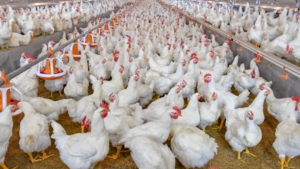
Broiler Chickens
“Broilers” is the term used in agriculture for chickens raised for their flesh. The primary breeders for broiler chickens are raised in sheds with automatic watering, feeding, and egg collection systems. They begin laying eggs at 24 weeks old and will lay for 40 weeks per cycle. It takes 24 to 32 hours for the hen to produce an egg and she will lay 150-180 eggs per year. Naturally, hens build nests, sit on their eggs, and vocalize with their young before they hatch. In the industry, chicks are taken away from their mothers and put into incubators to be warmed. Breeders will live for about a year before becoming “spent” and sent to slaughter.
Before factory farming, it took 112 days for chickens to reach 2.5 pounds. In 2020, chickens were over 6 pounds in just 47 days. Factory farming has focused on selective breeding to force desired traits onto animals raised for food. In the case of broiler chickens, they are bred to reach the largest weight in the shortest amount of time to produce more meat with less feed. Chicks are purchased and shipped through the mail at just one day old, which often harms the chicks as they are not yet able to regulate their body temperature and are vulnerable to weather conditions. After their traumatizing travels, birds have their beaks and toes seared or trimmed off without anesthesia to then be placed in tightly packed sheds for a short 40-some days before slaughter.
It is important to note that even “organic” or “free range” chickens suffer tremendously in factory farming. The USDA labelling is extremely lacking, having no definition of organic, free range, nor cage-free. According to Jonathan Safran Foer, in his book Eating Animals, free range means nothing: “Imagine a shed containing thirty thousand chickens, with a small door at one end that opens to a five-by-five dirt patch – and the door is closed all but occasionally” (p. 61). Free range or not, chickens raised in factory farms experience unimaginable conditions in order to maximize profits. Some common problems include: ammonia, cardiovascular dysfunction, integument lesions, ocular dysfunction, and skeletal dysfunction. Farmers know the dangers, so they estimate a loss percentage to account for at least 5% of the birds that will die before even reaching the slaughterhouse.
After their short 47-day life of pain, chickens are sent to slaughter. The most common practice used is live-shackle slaughter where birds are hung upside down by their fragile legs and sent through electrified water prior to having their throats slit and moving to the scalding tank. While the electrified water is meant to leave the chickens unconscious, it is commonly ineffective, leaving the birds to consciously experience the excruciating steps of this process. According to the Department of Agriculture, 1 million birds are boiled alive every year.
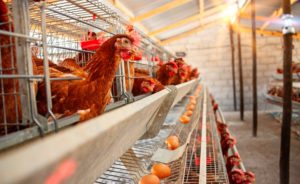
Egg Producing Hens
It is a common misconception that laying eggs is a natural process for chickens, so it doesn’t harm them like meat farming does. Unfortunately, the modern egg industry is no better than the meat industry. Chickens used in the industry today are descendants of Red Jungle Fowl, who lay 12-20 eggs annually. In 1947, farmed chickens produced 150 eggs per year, and today, chickens are bred to lay over 300 eggs annually. Hens are forced to lay eggs for 60-65 weeks and are then molted for about two weeks. Molting is a process used by the industry in which the chickens are starved so they stop producing eggs. It has been claimed that the process is used to rebuild calcium and restore body condition; however, this is harmful for chickens and is done so that hens lay more profitable eggs afterward. Molting often results in chickens eating their own feathers and behaving aggressively from the stress. Chickens endure this cycle of laying and molting one to three times and are then “spent” and sent to slaughter. About 30% of chickens arrive at the slaughterhouse with broken bones and other injuries from neglect and handling. Not surprisingly, male chicks are worthless in the egg industry and are therefore considered “waste”. Six billion male chicks are killed each year simply for being the wrong sex. They are either suffocated or put into a macerator, which grinds them up alive.
We often use the term “mother hen” to describe someone who is nurturing, which is super fitting as hens are extremely attentive and caring mothers to their chicks. Their instincts are to build nests and privately lay eggs while protecting and communicating with their offspring until they hatch. The egg industry strips away the mother’s opportunity to care for her offspring time and time again as her eggs are immediately sent down a chute before she has a chance to nurture. Fortunately, there are sanctuaries where the well-being of hens and chicks is prioritized rather than profit. Since birds have been selectively bred to over-produce eggs, Suprelorin F implants are sometimes used to stop ovulation and give hens a break from the pain of laying. These implants reduce chickens’ stress from the unnatural genetics they have been bred into, reducing the reproductive issues and common causes of death for the lucky few who have been saved.
Workers and the Environment
There have been many reports of safety hazards and unfair treatment to meat industry workers; however, these issues have been significantly highlighted during the COVID-19 pandemic. At just one Tyson Foods facility, 1,000 of the 2,800 employees had tested positive for COVID-19. Further, the USDA was sued for unsafe working conditions with almost 40,000 meatpacking workers testing positive for COVID-19 and over 150 deaths while line speeds continued to increase. Line speeds dictate the number of birds slaughtered in a certain period of time. The faster the line speeds, the greater the chance of failed stunning, animal abuse, and worker injury. Workers also reported a lack of personal protective equipment, lack of social distancing, and comments from management such as: “they had a responsibility to keep working in order to ensure Americans don’t go hungry” and “we all have symptoms – you have a job to do”.
The industry so far has gotten away with unsafe worker conditions, while also avoiding regulations that control pollution. 86 million tons of chicken manure is produced in a year, contributing to water and carbon pollution. 12 million pounds of nitrogen is added to the Chesapeake Bay each year by the chicken industry alone, contributing to the destruction of both wildlife and wildlife habitat. All of this is from the production of chicken flesh and eggs. After production, the industry is heavily involved in international trade, which significantly worsens the harmful effects of agriculture on the environment.
Chickens as Individuals
Chickens are not dumb. Chickens are not too “chicken” or scared. Chickens are intelligent, sentient beings. They love toys, treats, praise, and dirt baths. With over 30 different calls, hens can communicate with their chicks when they are still inside the egg allowing for her to know when her eggs will hatch and the chick to recognize his or her mother as soon as it’s hatched. They recognize their siblings and, when given the opportunity, choose to stay with their family and familiar friends for life. Chickens have been shown to choose food laced with morphine when they’re in pain, and choose food not laced when they are without pain. They are able to understand object permanence – the understanding that objects continue to exist when out of sight. And they are willing to delay instant gratification when doing so gets them more of what they want.
Unfortunately, chickens also experience learned helplessness – abnormal, chronic fear stimulated by inescapable captivity. This is common in factory farmed chickens deprived of all their natural abilities, but it is also shown in nature. Ethel Murmur was a chicken who witnessed the death of her friend Bertha. Ethel was so hurt from the experience, her behavior changed from vocalizing joy and need for attention to quiet and barely able to move. She died after a week of pain from watching her friend die. Another chicken named Sonia showed empathy toward her human caregiver. Sonia saw her befriended human crying on the floor and got up from where she sat to walk over to the human, rest her head on her shoulder and softly purr to comfort her. Chickens, without a doubt, deserve the opportunity to express their natural instincts and behaviors without being stripped of all comforts and happiness for human preference and convenience.
The Duck Industry
Ducks are the second most slaughtered land animals in the world with chickens being the first. They are easy to raise and are turned into products that are more profitable than chicken. Along with chickens, ducks are not protected by the Humane Slaughter Act nor the Animal Welfare Act. With the duck meat industry in Australia being $100 million dollars a year with 5% increases, the number of ducks slaughtered per year continues to increase. The duck industry is very similar to the chicken industry in the treatment of animals and processes.
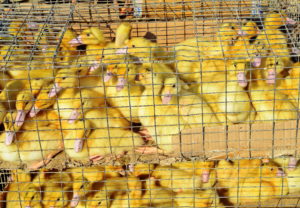
Meat and Eggs
In the wild, ducks live 10-15 years. In a factory farm, ducks are tortured until their slaughter at just 6-7 weeks old. Like chickens, ducks are bred and then transported to live in confinement under unnatural and usually intolerable conditions. They are debeaked as ducklings by scissors, hot blades, and searing. This process removes up to half of their bill without anesthesia, so they can feel every bit of it because of the nerve endings through their entire beaks. It often results in sensory deprivation due to lost sensory receptors. After being roughly transported and debeaked, ducks are placed in facilities lacking space, light, and water. The average density of floor space is about 7 birds per 10 square feet. This lack of space and opportunity to partake in natural activities sometimes leads to cannibalism. Ducks are typically kept on mesh floors with bedding, which is painful for them due to sensitive skin covering their feet. The flooring can lead to issues with balance, injury to feet and legs, and disease. Without adequate access to water, ducks are not able to thermoregulate and often experience heat stress. Further, the bedding used on duck farms is not changed throughout the breeding cycles. Duck manure contains 90% moisture; therefore, the ammonia in duck facilities is almost four times worse than that of chickens and often leads to burnt lungs for both ducks and workers.
Some of the most unfortunate ducks become foie gras. Foie gras is a very expensive meat made from fatty duck liver. It can cost between $50-90 for just one pound. In the wild, ducks sometimes eat more than usual to sustain themselves through migration. It was found that their livers are “tastier” when they consume more food than they need. Therefore, factory farming decided to unnaturally replicate this process by force-feeding ducks into liver failure. Long tubes are forced down their throats two times a day to engorge the liver and produce this dish. Typically, a duck liver weighs about 76 grams. A duck raised for foie gras will have a liver weighing up to 980 grams.
Like chickens, ducks also experience live-shackle slaughter. However, the electrified water bath that is meant to render the birds unconscious often does not work with ducks as it is made for chickens and turkeys. It is common that the brain is missed in the water bath with the currents going throughout the body instead, which may lead to cardiac arrest. Because it is painful to be hung upside down with weak leg bones, ducks often flap their wings during the live-shackling, causing them to be pre-stunned by the electrified water. Live-shackle slaughter often does not render birds unconscious or kill them quickly. Birds commonly live throughout the whole process all the way until being defeathered.
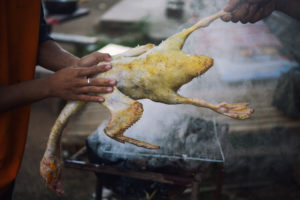
Down
Down is the feathers closest to a bird’s skin near the chest and belly that provides insulation. Humans take these feathers from ducks to use as thermal insulation for clothes, pillows, and many other items. Feathers are usually collected after ducks are slaughtered (although some are still living after “slaughter” to experience it), but they are sometimes collected by live plucking living birds. As one may imagine, this is a cruel and painful process for the ducks causing tearing of the skin, bleeding, pain and stress. Although there is a Responsible Down Standard (RDS) that does not stand for live plucking, investigators have found suppliers ignoring the mandate. Live plucked down is actually sought after by some suppliers because it has a higher fill power and, therefore, higher value because birds are kept alive longer and plucked over and over.
Ducks as Individuals
There are around 160 different duck species all over the world (except Antarctica) who live in both fresh and sea water. Humans often associate ducks with their famous “quack”; however, there are many ducks who do not quack and instead grunt, whistle, and yodel. Ducks have about 30 different kinds of calls used to communicate. These beautiful birds are wonderful mothers, not surprisingly. Ducks preen often to keep themselves and their nest clean. Mommas usually stay with ducklings until they are able to fly, although the caretaking varies between species. Ducks and ducklings are super fast learners with newborns swimming the same day they’re born! When ducklings lose their mothers, they are able to travel up to a mile to find her.
Again like chickens, ducks are intelligent sentient beings able to form close relationships with other ducks, other non-human animals, and humans. Male ducks do not usually hang around after mating season; however, one particular duck was spotted attending to a blind female. He made sounds for her and guided her to the lake – labelled a “seeing-eye duck” by the witnessing humans. Another sweet duck, Consuela, likes to sing along to music on the radio and bop nose to beak with her yellow lab friend. Another impressive duck, Peepers, went from being scared of people to vocal and attention-seeking. After being treated kindly, he finds comfort in the arms of humans and uses his neck to avoid being put down before he is ready. Lastly, wild ducks have been found to seek refuge on safe, private lands (such as sanctuaries) during hunting season. They have the ability to recognize the time when they are in particular danger and find creative ways to keep themselves safe from humans.
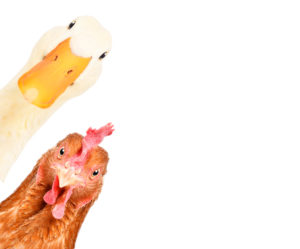
What can you do?
If you are not a fan of factory farming and the cruel treatment these birds are subjected to, the best thing you can do to make a change in the world is to educate yourself. It is so easy to hide away from the terrors in our world, but it is certainly best for the environment, the animals, and our fellow humans for each and every one of us to become aware of what is happening and learn what we can do to make positive change. Click here for a great resource to get started learning about chickens, ducks, and other birds commonly used in the poultry industry or here to see a recording of the Second Annual Humane Hoax Chicken Webinar where you can learn more about the complex lives of chickens.
More importantly, go vegan! Keeping animals off of our plate is the absolute best thing we can do for their well-being. Many people think that making this lifestyle change will be too hard and choose to avoid information and change. However, thanks to all of the seasoned activists in the world, there are so many resources, recipes, and alternatives that make it so easy and fun to be vegan. Check out these reasons to not eat chicken and some egg replacements that may help for anyone interested in even just one change in diet and lifestyle. The Animal Advocates of South Central PA has endless resources including a vegan challenge that provides step by step guidance and support for making the transition!
Finally, get involved in the world of animals! There are many organizations fighting to end the suffering of animals. You can volunteer with The Humane League, an organization working toward ending the abuse of animals raised for food. The Humane League focuses closely on chickens as they are the most abused land animal raised for food. They reach out to businesses to advocate for vegan options and improve animal welfare policies, such as the Better Chicken Commitment. Another great way to get involved is to visit, volunteer with or donate to one of the many amazing animal sanctuaries. Here in South Central PA, we are lucky to have a number of local sanctuaries where you can meet chickens, ducks, pigs, goats, cows, and more! There is no better way to understand how awesome beings are than to watch them exist in a natural space doing what they do best.
About the author
Jamie Albrecht started practicing a vegan lifestyle in September 2020. She participated in the ScPA Vegan Challenge assuming it would be a difficult month-long experiment, but veganism quickly transformed into a fulfilling lifelong commitment. Jamie now regularly volunteers with AASCPA, The Humane League and Huckleberry Trails Animal Sanctuary, where she discovered her adoration for sheep thanks to the Fab Four (Patrick, Loki, Rocky, and Odin). She also adores her family, including her spouse (Zack), beagles (Cooper and Bailey), and kitty (Toof).
References and Resources
- https://www.upc-online.org/respect/#:~:text=May%204%20is%20International%20Respect,International%20Respect%20for%20Chickens%20Month.
- https://www.peta.org/living/food/may-international-respect-chickens-month/
- https://www.youtube.com/watch?v=hOxYfopvpd0
- https://www.nal.usda.gov/awic/humane-methods-slaughter-act
- https://extension.psu.edu/modern-meat-chicken-industry
- https://sentientmedia.org/broiler-chickens/
- https://animalplace.org/put-an-end-to-the-shipment-of-day-old-chicks/
- https://assets.ctfassets.net/ww1ie0z745y7/4Kxq1PEVJKqdcIXqzjXnna/baf178db3764cdbb3e109e3dc58c923e/live-shackle-slaughter-factsheet-final.pdf
- https://www.ams.usda.gov/sites/default/files/media/USDA%20Grademarked%20Product%20Label%20Submission%20Checklist.pdf
- https://www.youtube.com/watch?v=9NycfbN3DDk
- https://extension.psu.edu/modern-egg-industry#:~:text=Most%20producers%20like%20flocks%20to,every%20dozen%20eggs%20they%20produce.&text=Once%20the%20hens%20lay%20for,they%20are%20rested%20or%20molted.
- https://www.milliondollarvegan.com/egg-farming/#:~:text=The%20Egg%20Production%20Process&text=Like%20male%20dairy%20calves%2C%20these,waste%20the%20feed%20on%20them.
- https://www.peta.org/issues/animals-used-for-food/factory-farming/chickens/egg-industry/
- https://www.kinderworld.org/videos/egg-industry/baby-chicks-ground-up-alive/
- https://microsanctuary.org/2020/05/13/our-experiences-with-suprelorin-implants-for-rescued-layer-hens-by-karina-donhardt-garden-of-edhen/
- https://www.npr.org/2020/11/19/936905707/tyson-managers-suspended-after-allegedly-betting-if-workers-would-contract-covid
- https://animalequality.org/slaughterhouse-line-speeds/
- https://www.foodandwine.com/news/10000-tyson-employees-positive-covid-19
- https://www.youtube.com/watch?v=xpxJ5xJTHek
- https://www.newsweek.com/americas-chicken-wing-shortage-bad-planet-1587282
- https://www.freeforlife.org/facts.html
- http://thinkdifferentlyaboutsheep.weebly.com/sentience-in-farm-animals-poultry-chickens.html
- https://www.upc-online.org/thinking/210501_do_chickens_mind_seeing_other_chickens_traumatized_in_their_presence.html
- https://www.humanesociety.org/sites/default/files/docs/hsus-report-animal-welfare-duck-industry.pdf
- https://sentientmedia.org/duck-farming/
- https://www.aphis.usda.gov/aphis/ourfocus/animalwelfare/sa_awa
- https://www.youtube.com/watch?v=SzwV2ZwV1g4
- https://kb.rspca.org.au/knowledge-base/what-are-the-animal-welfare-concerns-with-the-production-of-down-feathers/
- https://www.cbsnews.com/news/a-foul-truth-behind-the-down-in-pillows-and-comforters/
- https://www.youtube.com/watch?v=dqS5dX2DpwY#action=share
- https://onekindplanet.org/animal/duck/
- http://thinkdifferentlyaboutsheep.weebly.com/sentience-in-farm-animals-ducks.html
- https://www.peta.org/living/food/top-10-reasons-eat-chickens/
- https://www.peta.org/living/food/egg-replacements/
- https://www.animaladvocatesscpa.com/programs/2018-vegan-challenge/
- https://www.upc-online.org/resources.html
- https://us02web.zoom.us/webinar/register/WN_gYTfV3fiT0OqFtZVsuZhiw
- https://thehumaneleague.org/
- https://www.animaladvocatesscpa.com/resources/local-animal-sanctuaries/

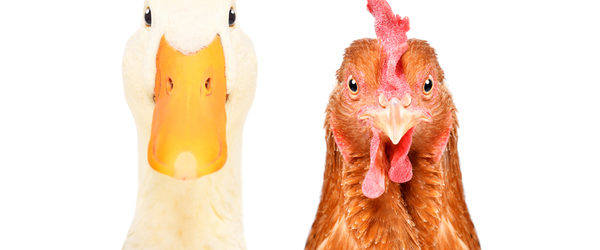
Leave a Reply